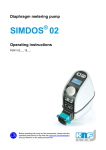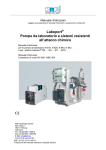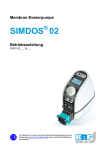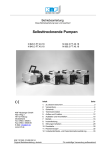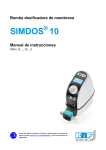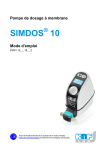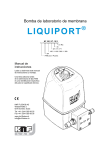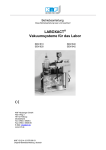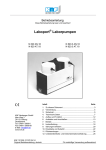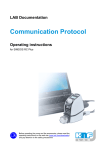Download Autostart AS-6210 Installation manual
Transcript
Diaphragm metering pump SIMDOS ® FEM 1.10 KT .18 S S / RC .18 KT / TT / FT [Chapt. 4] 1.10 FEM / UFEM - / PMLxxxx / PLxxxx [Chapt. 1] Operating Manual It is important to read and comply with all instructions in this operating and installation manual. An additional letter before the FEM model code is a country-specific designation, with no technical relevance. KNF FLODOS AG Wassermatte 2 6210 Sursee, Switzerland Tel. +41 (0)41 925 00 25 Fax +41 (0)41 925 00 35 www.knf-flodos.ch [email protected] KNF Flodos BA_SIMDOS_EN_02_160044.docx Translation of original operating manual Please keep for future reference! Items included on delivery: KNF FLODOS AG Wassermatte 2 6210 Sursee, Switzerland Tel. +41 (0)41 925 00 25 Fax +41 (0)41 925 00 35 www.knf-flodos.ch [email protected] SIMDOS metering pump Mains plug RC cable (for RC version only) Operating manual Brief user guide Operating manual CD-ROM Connection kit: hose and screw connectors Safety provisions The SIMDOS 10 metering pump complies with the safety provisions of the EC low-voltage directive 2006/95/EC and the EC directive on electromagnetic compatibility 2004/108/EG. The following standards are applicable: Contents 1. 1.1. 1.2. 2. 2.1. 2.2. 3. 4. 4.1. 4.2. 4.3. 4.4. 4.5. 4.6. 4.7. 5. 5.1. 5.2. 5.3. 5.4. 6. 6.1. 6.2. 6.3. 6.4. 6.5. 6.6. 7. 7.1. 7.2. 7.3. 7.4. EN 61010-1 EN 61326-1 Page About this document 3 Use of the operating and installation manual3 Symbols and flags 3 Use 4 Intended use 4 Improper use 4 Safety 5 Technical data 7 Pump materials 7 Hydraulic ratings 7 Accuracy / reproducibility 8 Hydraulic connections 8 Electrical data 9 Other parameters 9 External drive (RC version only) 10 Structure and operation 11 Metering pump structure 11 Operating principle 11 Metering pump functions 12 Functions overview 13 Assembly and connection 14 Assembly 14 Electrical connection 15 External drive (RC version) 15 Hydraulic connection 16 Shutdown 18 Transport and interim storage 18 Operation 18 Initial start-up 18 Operating controls 19 Main display 19 Switching the pump on and off 20 Contents 7.5. 7.6. 7.7. 7.8. 7.9. 7.10. 7.11. 7.12. 7.13. 7.14. 7.15. 7.16. 7.17. 7.18. 7.19. 7.20. 8. 8.1. 8.2. 8.3. 8.4. 9. 9.1. 9.2. 9.3. Page Starting the pump 21 Interrupting a pumping operation 21 Stopping the pumping operation 21 Entering settings 22 Specified flow 24 Flow unit 24 Timeout with time counter 24 Priming 25 Fluid type 25 Calibration 26 System settings 27 Back to main menu 27 Language setting 27 Auto start 28 Contrast 29 Reset 29 RC version – external drive 30 External drive analogue input 30 Digital input 1, Start/Stop 32 Digital input 2, Reset/Prime/Pedal switch 34 Digital output 36 Maintenance 37 Maintenance plan 37 Cleaning 37 Cleaning/replacing valve plates and pump diaphragm 38 10. Troubleshooting 42 11. Spare parts and accessories 44 11.1. Spare parts 44 11.2. Accessories 44 12. Decontamination statement 45 SIMDOS diaphragm metering pump About this document 1. About this document 1.1. Use of the operating and installation manual The operating and installation manual forms an integral part of the pump. Please be sure to pass the manual on to the next owner of the device. Project pumps Specifications and instructions for customer-specific project pumps (model numbers beginning with “PL” or “PML”) may differ from those set down in the operating and installation manual. For project pumps, it is also necessary to observe the agreed specifications. 1.2. Symbols and flags Warning symbol Warning regarding a potential danger. Possible consequences of failure to comply with the warning. The word used, e.g. “warning”, indicates WARNING the level of danger present. Precautions required to prevent the danger and its consequences. Levels of danger Word Meaning DANGER Warning of an imminent danger WARNING Warning of a potential danger CAUTION Warning of a potentially dangerous situation Consequences of noncompliance Death or serious injury, or major damage to property Possible death or serious injury, or major damage to property Possibility of slight injury or damage to property Tab. 1: Levels of danger Other flags and symbols Identifies an action (step) to be carried out. 1. Identifies the first step of an action. Further numbered steps follow. Identifies important information. KNF Flodos BA_SIMDOS_EN_02_160044.docx Translation of original operating manual 3 Use SIMDOS diaphragm metering pump 2. Use 2.1. Intended use The pump is a fluid pumping and metering device. Operator’s responsibility Operating parameters and conditions The pump must be installed and operated only in accordance with the operating parameters and conditions described in Chapter 4, Technical data. Protect the pump from moisture. The pump may be operated only when fully assembled. Requirements for pumped medium Before use, check that the materials of the pump head, housing, diaphragm and valves are compatible with the pumped medium. Before starting to pump, check that the medium can be pumped safely in this specific situation. The temperature of the medium must be within the permitted temperature range (see Chapter 4). The pumping medium must not contain any solids, since these could impair the pump’s operation. If the presence of solids cannot be prevented, a filter of < 50 µm and with a sufficient filter area must be installed upstream from the pump. 2.2. Improper use The pump must not be operated in a potentially explosive atmosphere. The party commissioning the pump is responsible for ensuring compliance with relevant standards if the pump is used in the medicine or food sectors. 4 KNF Flodos BA_SIMDOS_EN_02_160044.docx Translation of original operating manual SIMDOS diaphragm metering pump 3. Safety Safety Note the safety notes in Chapter 6, Assembly and connection, and Chapter 7, Operation The pump is constructed according to the generally accepted rules of the technology, and occupational health and safety and accident prevention provisions. Hazardous situations with the possibility of injuries to the user or other persons, or damage to the pump or other property, may, however, occur during use of the device. The pump must be operated only in technically sound condition and for its intended purpose, with due regard for safety and potential hazards and in accordance with this operating and installation manual. Personnel Ensure all persons working with the pump have been appropriately trained and familiarised with its use, or are qualified personnel. This applies particularly to the assembly, connection and maintenance of the equipment. Ensure that relevant personnel have read and understood this operating and installation manual, particularly the chapter on safety. Safety awareness Accident prevention and safety rules must be observed at all times while working on or using the pump. Hazardous media When pumping a hazardous medium, always observe the safety rules for the medium in question. Signs Always comply with instruction signs placed on the pump, such as flow direction arrows and the type plate, and keep these in a clearly legible condition. Environmental protection All replacement parts must be stored and disposed of in accordance with the precautions required under environmental protection provisions. It is important to comply with both national and international regulations. This applies particularly to parts that have been contaminated with toxic materials. Disposal Dispose of all packaging in an environmentally appropriate manner. The packaging materials are recyclable. Ensure that the pump is disposed of in an environmentally appropriate manner at the end of its useful life. Use appropriate waste collection systems for the disposal of endof-life equipment. Used pumps contain valuable recyclable materials. KNF Flodos BA_SIMDOS_EN_02_160044.docx Translation of original operating manual 5 Safety SIMDOS diaphragm metering pump EU directives/standards The pumps are in accordance with the requirements of the guidelines 2011/65/EU (ROHS2) The pump complies with all relevant provisions of the following directives: the EC machinery directive 2006/42/EC, safety provisions of the EC low-voltage directive 2006/95/EC and the EC directive on electromagnetic compatibility 2004/108/EC. The following harmonised standards are met: EN 61010-1 EN 61326-1 Customer service and repairs All repairs to the pump must be carried out solely by the accredited KNF customer service entity. Use only KNF original parts for all maintenance work. 6 KNF Flodos BA_SIMDOS_EN_02_160044.docx Translation of original operating manual SIMDOS diaphragm metering pump Technical data 4. Technical data 4.1. Pump materials For KT models: 1) Sub-assembly Pump head Valve plate / seals Diaphragm Housing Tab. 2: KT Material PP FFKM PTFE-coated PP 1) according to DIN ISO 1629 and 1043.1 For TT models: 1) Sub-assembly Pump head Valve plate / seals Diaphragm Housing Tab. 3: TT Material PVDF FFKM PTFE-coated PP 1) according to DIN ISO 1629 and 1043.1 For FT models: 1) Sub-assembly Pump head Valve plate / seals Diaphragm Housing Tab. 4: FT Material PTFE FFKM PTFE-coated PP 1) according to DIN ISO 1629 and 1043.1 4.2. Hydraulic ratings Parameter 1), 2) Flow rate [ml/min] Max. metering volume [ml] Metering time [mm:ss] [hh:mm] Flow rate scale range 3) Accuracy 3) Reproducibility Permitted pressure [bar above atmospheric] Suction head [m water column] 4) Permitted medium viscosity [cSt] Value 1–100 1–1,000 1s – 99h59min 1:100 +/- 2% +/- 1% 6 3 150 Tab. 5: Hydraulic ratings 1) Measured with water at 20°C 2) Flow rates may vary from the values shown according to fluid viscosity, pump head material and the hoses / hose connectors used. Calibration with the pumped medium is required. 3) For calibrated pump and constant environmental conditions (see section 5.5) 4) Lower flow rate for fluid type setting “Visk500cSt” (see section 7.13). KNF Flodos BA_SIMDOS_EN_02_160044.docx Translation of original operating manual 7 Technical data SIMDOS diaphragm metering pump 4.3. Accuracy / reproducibility Accuracy The accuracy of the metering pump is appropriately characterised by the maximum absolute error A and the maximum relative error B. max. inaccuracy ≤ A + B Error Absolute error A Relative error B Value ≤ ± 1‰ nominal value ≤ ±1.9% setting value Tab. 6: Error A and error B Example: ® SIMDOS 10, nominal value of 100 ml/min For a setting of 20 ml/min, the accuracy should therefore be within the following error limits: Inaccuracy ≤ (±1‰ x 100ml/min) + (±1.9% x 20ml/min) ≤ (±0.1ml/min) + (±0.38ml/min) ≤ ±0.48ml/min ≈ ±2% of setting value Reproducibility In constant environmental conditions and with the same hose connection configuration, the pump achieves a reproducibility of better than ±1%. Greater inaccuracies may occur for fluids with a viscosity of > 150 cSt or with a tendency to gassing out. Appropriate adjustments may be made during calibration. Factory calibration Calibration The metering pump has been calibrated to its nominal flow rate in the factory. The specified flow rate is for water at 20°C with free discharge flow. The flow rate may differ from the calibrated value for some applications, according to the medium, its viscosity, density and temperature, pressure and installation type (e.g. cross-section constrictions). For accurate metering, it is therefore desirable to calibrate the metering pump (see section 7.14). 4.4. Hydraulic connections Pump model FEM 1.10 KT, TT Connection type Hose fitting, i.d. 4mm / o.d. 6mm Internal thread NPT 1/8 Hose fitting, i.d. 4mm / o.d. 6mm Hose fitting, i.d. 1/8”, o.d. 1/4” Internal thread NPT 1/8 Hose fitting, i.d. 1/8”, o.d. 1/4” FEM 1.10 FT UFEM 1.10 KT, TT UFEM 1.10 FT Tab. 7: Hydraulic connections 8 KNF Flodos BA_SIMDOS_EN_02_160044.docx Translation of original operating manual SIMDOS diaphragm metering pump Technical data 4.5. Electrical data Parameter Nominal mains voltage [V] Frequency [Hz] Maximum current consumption AC 100 V / 115 V / 240 V [A] Max. watt consumption [W] Pump DC voltage [V] Max. current consumption, DC RMS 24 V [A] Max. short-term peak current [A] Power supply protection Pump protection Pump protection type Power supply protection type Value 100–240 V AC +/- 10% 50–60 Hz 0.1 / 0.09 / 0.05 10 24 V DC 0.4 1.7 Electronic overload protection Electronic overload protection IP 65 IP 40 Tab. 8: Electrical data 4.6. Other parameters Parameter Permitted ambient temperature Permitted medium temperature Rated speed Service life Noise level 1) Pump weight Value +5 to +40°C +5 to +80°C 200 rpm > 10,000 h (100 million strokes) < 40dBA 0.9 kg Tab. 9: Other parameters 1) Pump weight may differ slightly for some pump versions. KNF Flodos BA_SIMDOS_EN_02_160044.docx Translation of original operating manual 9 Technical data SIMDOS diaphragm metering pump 4.7. External drive (RC version only) Parameter Value Analogue input Signal range 0–10 V, 4–20 mA, 0–20 mA Input resistance [Ω] 13.9 kΩ at 0–10 V 470 Ω at 4–20 mA 470 Ω at 0–20 mA 24 V DC Electric strength [V] TTL Digital input Signal range Electric strength [V] TTL Low level (ON) High level (OFF) Pull up at 24 V 24 V DC < 0.8 V = low > 2.0 V = high Digital output Electric strength, open collector [V] TTL Load capability, open collector [V] TTL 24 V DC 10 mA Tab. 10: External drive 1 2 3 4 5 Analogue input brown Digital input 1 white Digital input 2 blue Open collector output black Ground grey Fig. 1: RC cable pins Pin No. Wire colour 1 Brown Description Analogue input 2 3 White Blue Digital input 1 Digital input 2 4 5 Black Grey Digital output Ground Function 0% to 100% up to flow rate Start/stop Reset / prime / pedal switch Various output signals -- Tab. 11: RC cable pins 10 KNF Flodos BA_SIMDOS_EN_02_160044.docx Translation of original operating manual SIMDOS diaphragm metering pump 5. Structure and operation Structure and operation 5.1. Metering pump structure 1 2 3 4 5 6 7 8 9 STOP button START button Display Control knob Inlet Pump head Outlet Power supply plug External drive plug (RC version only) Fig. 2: Diaphragm pump 5.2. Operating principle 1 2 3 4 5 6 7 Exhaust valve Inlet valve Working chamber Diaphragm Eccentric Connecting rod Pump drive Fig. 3: Pump structure Diaphragm fluid pumps are based on reciprocating displacement pump technology. An elastic diaphragm (4) is moved up and down by the eccentric (5) and the connecting rod (6). During the down stroke, the diaphragm sucks in the medium through the inlet valve (2). During the up stroke, it forces medium out of the pump head through the exhaust valve (1). The diaphragm hermetically seals off the working chamber (3) from the pump drive (7). ® SIMDOS diaphragm metering pumps are fitted with a patented drive system. The suction stroke is always driven at maximum speed, but the exhaust process is varied according to the selected speed, ensuring maximum possible uniformity of discharge during the entire stroke (see Fig. 4). This results in a low-pulsation, quasicontinuous pumping process. This is the key difference between ® SIMDOS metering pumps and diaphragm metering pumps with linear magnet diaphragm drive or with conventional eccentric diaphragm drive. KNF Flodos BA_SIMDOS_EN_02_160044.docx Translation of original operating manual 11 Structure and operation SIMDOS diaphragm metering pump 100% flow rate 1% flow rate Fig. 4: Low-pulsation operating principle The characteristic curve for the suction and exhaust strokes can also be adapted to the medium by setting the appropriate fluid type (see section 7.13). 5.3. Metering pump functions Operating modes Continuous pumping In this case, the device pumps at a constant flow rate. Fig. 5: Continuous pumping Continuous pumping with timeout In this case, the device pumps at a constant flow rate, then switches off after a specified time. Fig. 6: Continuous pumping with timeout Metered volume Pumping of a specified volume in a specified time. Fig. 7: Metered volume with timeout 12 KNF Flodos BA_SIMDOS_EN_02_160044.docx Translation of original operating manual SIMDOS diaphragm metering pump Structure and operation 5.4. Functions overview Main menu 1. Flow rate 1–100 ml/min or metered volume 1–1,000 ml 2. Timeout/metering time 3. High-speed operation for priming or emptying 4. Pump calibration 5. Setting the pump for characteristics of the medium - Standard: Aqueous media - Degassing: Media with low boiling temperature - Visk100cSt: Media up to 100 cSt - Visk500cSt: Media up to 500 cSt 6. Go to system menu Fig. 8: Main menu System menu 7. Return to main menu 8. Selecting operating menu language 9. Analogue input: 0% to 100% flow rate * 0–10 V / 0–20 mA / 4–20 mA 10. Digital input 1: Start/stop with level or pulse signal via logic input * 11. Digital input 2: Reset or high-speed via logic input * 12. Digital output: User selection of logic signal type: * - Error/alarm - Motor turns (level) - End of metering volume - Motor pulses - Volume pulses (one pulse per 100 µl) 13. Autostart function (pump starts automatically when power supply switched on) 14. Set display contrast 15. Reset pump to factory settings 16. Return to main menu Fig. 9: System menu * RC functions are available for RC pumps only. See Chapter 8 for further details of the external drive system. KNF Flodos BA_SIMDOS_EN_02_160044.docx Translation of original operating manual 13 Assembly and connection SIMDOS diaphragm metering pump 6. Assembly and connection All pumps must be installed only in accordance with the operating parameters and conditions described under Technical data (see Chapter 4). Note the safety instructions in Chapter 3. 6.1. Assembly Store at the assembly location prior to assembly so that the pump is at the same temperature as the surrounding environment. Dimensions Pump dimensions (see Fig. 10) Fig. 10: Mounting measurements (measurement tolerances as per DIN ISO 2768-1, tolerance class V) Installation location Ensure that the installation location is dry, and protected from water in the form of rain, spray, splashes and drips. Select a level surface that will provide a firm base for the pump. When choosing the location, ensure that the hose connections can be fitted without strain on the hoses. Do not pull on the hoses, and avoid kinks and bends. Protect the pump from dust. Protect the pump from vibrations and impacts. Installation position The pump is designed to be installed in an upright position. Two additional mounting screws can be inserted from the bottom of the pump base (see Fig. 10). 14 KNF Flodos BA_SIMDOS_EN_02_160044.docx Translation of original operating manual SIMDOS diaphragm metering pump Assembly and connection 6.2. Electrical connection Electrical connections must comply with relevant standards, directives, regulations and industry standards. 1. Connect the mains plug cable to the socket in the pump. 2. Plug the mains plug into a correctly installed and properly earthed mains socket. Fig. 11: Electrical connection The pump must be connected only to a correctly installed and properly earthed mains socket. Ensure that the mains plug is protected from water splashes. Safety note CAUTION Always remove the mains plug from the socket before carrying out any work on the pump. 6.3. External drive (RC version) RC cable 1. Fit an appropriate plug on the external drive cable (RC cable) for the control unit to be used. For pin allocations, see section 4.6, Table 10 and Fig. 1). 2. Remove protective cover from the RC plug. 3. Connect the RC cable to the pump. Signals and load capacity (see section 4.6). RC functions (see Chapter 8). KNF Flodos BA_SIMDOS_EN_02_160044.docx Translation of original operating manual 15 Assembly and connection SIMDOS diaphragm metering pump 6.4. Hydraulic connection Connected components All components connected to the pump must be designed for the hydraulic ratings of the pump (see Chapter 4). Hoses All hoses used must be designed for the maximum permitted operating pressure of the pump (see Chapter 4). All hoses used must have sufficient chemical resistance to the pumped fluids. Customer-specific pumps (PL, PML) The connections described below apply to standard products. Different connections may apply for customer-specific projects (PML or PL). The direction of flow is marked on the pump head. The suction line should be kept as short as possible, to reduce the priming time. Clamp ring / hose connection fitting, FEM 1.10KT, FEM 1.10TT, UFEM 1.10KT, UFEM 1.10TT 1 2 3 4 Hose Union nut Clamp ring Connector Fig. 12: 4/6 hose / clamp ring connection fitting (FEM) 1/8” / 1/4” hose / clamp ring connection fitting (UFEM) 1. Remove protective covers from the connections. 2. With a sharp knife, cut the suction and pressure lines (FEM: hose with i.d. 4 mm, o.d. 6 mm; UFEM: hose with i.d. 1/8”, o.d. 1/4”) to the required length, with square straight edges. 3. Push the union nut (2) and clamp ring (3) onto the hose (1). 4. Push the hoses onto the connectors as far as they will go. 5. Hand-tighten the union nut (2). 6. Check that the hoses and hose/connector transitions are correctly and securely attached. 7. Check the tight seal of the installed fittings. 16 KNF Flodos BA_SIMDOS_EN_02_160044.docx Translation of original operating manual SIMDOS diaphragm metering pump Assembly and connection Cutting ring / hose connection fitting with threaded socket FEM 1.10FT, UFEM 1.10FT 1 2 3 4 5 6 7 Hose Threaded socket Teflon sealing tape Union nut Cutting ring Sealing ring Connector Fig. 13: 4/6 hose / cutting ring FT connection fitting 1. Remove protective covers from the connections. 2. Screw the threaded socket (2) with Teflon sealing tape (3) into the pump head. Do not apply excessive torque to the threaded socket. This could damage the thread. 3. Using a sharp knife, cut the suction and pressure lines (FEM: hose with i.d. 4 mm, o.d. 6 mm; UFEM: hose with i.d. 1/8”, o.d. 1/4”) to the required length, with straight square edges. 4. Push the union nut (4), cutting ring (5) and sealing ring (6) onto the hose (1). Push the cutting ring and sealing ring over the hose only far enough for the hose end to protrude around 1 mm. 5. Push the hoses onto the connectors as far as they will go. 6. Hand-tighten the union nut (4). Fig. 14: Position of cutting ring and sealing ring on hose 7. Check that the hoses and hose/connector transitions are correctly and securely attached. 8. Check the tight seal of the installed fittings. KNF Flodos BA_SIMDOS_EN_02_160044.docx Translation of original operating manual 17 Operation SIMDOS diaphragm metering pump 6.5. Shutdown On completion of the pumping operation, flush the entire system and the pump with a neutral fluid, then pump it empty. To ensure satisfactory start-up when the unit is again required, it is important to ensure that the pump is free of any crystallising, adhesive or curing media. Press the STOP button to end the pumping operation. Unplug the pump from the power supply. 6.6. Transport and interim storage When packing the unit, ensure that the consignment will not be able to move within the packing. Choose sufficiently robust packing so that the entire consignment will withstand unfavourable transport conditions. Use the original packaging. 7. Operation 7.1. Initial start-up Before switching on the pump, check the following points: Prerequisites for start-up All hoses must be correctly attached. Specifications of the power supply must correspond with the data on the pump type plate and the mains plug. The pump outlet must be clear of any obstruction. All cables must be correctly connected. Tab. 12: Prerequisites for start-up Operate the pump only in accordance with the operating parameters and conditions described under Technical data (see Chapter 4). Ensure the pump is being used for its intended purpose (see section 2.1). Avoid any improper use of the pump (see section 2.2). Note the safety instructions in Chapter 3. If the lines are blocked lines a diaphragm pump can build up higher pressures than the maximum allowed limits which can either damage the pump or system. 18 KNF Flodos BA_SIMDOS_EN_02_160044.docx Translation of original operating manual SIMDOS diaphragm metering pump Operation If it is possible that pressures in excess to the limits can occur it is important to take the necessary measures, e.g. a pressure relief valve or pressure sensor. For further assistance contact your local KNF specialist. Never apply positive pressure to the suction side of the pump. A small positive pressure of less than 0.5 m water column will cause the pump to block flow in the pumping direction. On the application of any higher pressures than this, the pump will allow the fluid to pass through in the pumping direction. This can be prevented by using a suitable check / pressure valve* on the outlet side of the pump. * e.g. Pressure Control Valve FDV30 from KNF Flodos 7.2. Operating controls 1 2 3 4 STOP button START button Display Control knob Fig. 15: Operating controls 7.3. Main display The main display shows the principal pump settings. 1 2 3 4 5 6 7 8 9 10 Specified flow Flow unit Time counter Volumeter External drive Autostart Analogue input Digital input 1 Digital input 2 Operating condition display Fig. 16: Main display KNF Flodos BA_SIMDOS_EN_02_160044.docx Translation of original operating manual 19 Operation SIMDOS diaphragm metering pump Specified flow and unit Time counter Displays the set flow rate (1) if the unit (2) has been set on “ml/min”. Displays the metering volume (1) if the unit (2) has been set on “ml”. Displays the pump running time. Upward count (3) if no timeout has been programmed. Elapsed time display. Downward count (3) if a timeout (metering) has been programmed. Time remaining display. Volume meter Display of delivery volume (4) since last pump start-up. External drive Displays whether pump external drive has been activated, and the external drive condition (5, 7, 8, 9). Auto start Operating condition Displays whether pump has been set on Autostart (6). Displays whether the pump is operating, stopped or paused (10). 7.4. Switching the pump on and off The default setting is for the pump to remain off when the mains power supply is switched on. Switch on Briefly press the “STOP” button – the pump will switch on. The display lights up, and the pump is ready for use. Fig. 17: Switching the pump on Switch off Hold the “STOP” button down for at least 2 seconds. The pump will now switch off completely. Hold down for 2 seconds Fig. 18: Switching the pump off Standby When the pump is stopped, after ten minutes without any user input the device switches into standby condition (display goes dark). However, the pump is still ready for use immediately when required. Press “STOP” or any other key to reactivate the pump from standby condition. The external drive reactivates the pump from standby as soon as a control signal is present. 20 KNF Flodos BA_SIMDOS_EN_02_160044.docx Translation of original operating manual SIMDOS diaphragm metering pump Operation 7.5. Starting the pump Press the “START” button. The unit will begin pumping. The triangle symbol will appear in the display. An externally driven pump will start only if the external pump signals allow a pump start-up (see Chapter 8). Fig. 19: Starting the pump 7.6. Interrupting a pumping operation Press the “START” button. The pumping operation is interrupted. The pause symbol will appear in the display. When the pump is restarted from “Pause” condition, the interrupted pumping operation is continued. When in “Pause” condition, the pump responds to external control signals. Fig. 20: Interrupting a pumping operation 7.7. Stopping the pumping operation Press the “STOP” button, The pumping operation is interrupted. The pause symbol will appear in the display. Press the “STOP” button again. The pump will now switch to “Stop” condition, and reset the time counter and volumeter. The first time the user presses the “STOP” button puts the working pump into Pause condition. Fig. 21: Stopping the pumping operation Master Stop The pump goes into “Stop” condition only when the “STOP” button is pressed for the second time. Stopping the pump with the “STOP” button is called a “master stop”. The pump can then only be restarted manually. For a pump operated by external signals, the master stop first has to be manually cancelled by pressing the “START” button. A reset at digital input 2 cancels the master stop, and the pump can then be started externally. KNF Flodos BA_SIMDOS_EN_02_160044.docx Translation of original operating manual 21 Operation SIMDOS diaphragm metering pump 7.8. Entering settings Turn the control knob to move the display up or down. Fig. 22: Moving the operating menu up/down The lines in the middle of the display are enclosed in a frame, and can now be selected with the control knob. Fig. 23: Select the framed lines by pressing the control knob. The selected settings are marked with an inverted display. Now turn the control knob to change the value as required. Fig. 24: Inverted display of editable values Press on the control knob to confirm your input, and move to the next value in the same line, if any. Fig. 25: Confirming the setting value by pressing the control knob 22 KNF Flodos BA_SIMDOS_EN_02_160044.docx Translation of original operating manual SIMDOS diaphragm metering pump Operation Ending the setting operation: Keep pressing the control knob until no values are selected (values marked with inverted display). Then turn the control knob until the main display can be seen at the top of the operating menu. Press the “STOP” button: this ends the input operation, and the display switches back to the main display. The pump will stop when this operation is carried out. Press the “START” button: this ends the input operation, and the display switches back to the main display. The pump starts when this operation is carried out. After a period of 10 seconds with no settings entered, the pump terminates the input operation and automatically returns to the main display. The input value is now accepted. KNF Flodos BA_SIMDOS_EN_02_160044.docx Translation of original operating manual 23 Operation SIMDOS diaphragm metering pump 7.9. Specified flow The specified flow function is used to set the desired flow rate or metering volume. Input Flow rate Metering volume Unit Setting range Millilitres per minute [ml/min] 1.0–100.0 Millilitres [ml] 1.0–1,000.0 Tab. 13: Specified flow Fig. 26: Specified flow To ensure precise results, it is necessary to calibrate the pump (see section 7.14). The “Visk100cSt” and “Visk500cSt” fluid type settings reduce the flow rate values available for selection (see section 7.14). 7.10. Flow unit Switch from a specified flow rate [ml/min] to a specified metering volume [ml] by changing the unit. When millilitres [ml] are set as the unit for a metered volume, it is also necessary to program the time counter. The system automatically sets the shortest possible time with the maximum flow rate. Fig. 27: Flow unit 7.11. Timeout with time counter Use the time counter to terminate flow after the time shown on the counter. The metering operation is automatically calculated so that the required metering volume will have been reached on expiry of the time entered on the time counter. Fig. 28: Time setting in minutes Input Meaning - - min - - sec Timeout not active mm min ss sec Timeout active Setting range -1sec – 99h 59min Tab. 14: Timeout When millilitres [ml] are entered for the metering of a given volume, the permitted setting range for the time counter is restricted so that the flow rate will not be below or above the permitted flow rate for the pump. If millilitres [ml] have been entered, the time counter cannot be deactivated. The setting [- - min - - sec] is not possible. Fig. 29: Time setting in seconds 24 If millilitres per minute [ml/min] have been set, the time counter can be switched to the hours and minutes area. To do this, set the minute setting to more than 59 min. KNF Flodos BA_SIMDOS_EN_02_160044.docx Translation of original operating manual SIMDOS diaphragm metering pump Operation 7.12. Priming This function is for rapidly priming and emptying the pump head and lines. Press the control knob and hold in place for the duration of the priming/emptying operation. The pump will run at a higher speed during this time. Fig. 30: Priming The priming function interrupts a metering operation that is currently in progress. 7.13. Fluid type The fluid type setting is used to adjust the pump characteristic curve for different types of fluid. Select “Fluid Type” to enter the selection menu. The letter at the right end of the line identifies the currently active characteristic curve. The following settings are available for selection: Fig. 31: Fluid type Standard Symbol: S This is the optimum setting for all media with a viscosity similar to that of water. A uniform flow characteristic curve is obtained with short suction times and appropriate linearisation. Fig. 32: "Standard" fluid type Degassing Symbol: D This is the appropriate setting for media with a low boiling temperature, since these media are sensitive to any pressure drop and deceleration phenomena. The pump suction rate is reduced. The pumping characteristic curve limits fluid acceleration and deceleration to the maximum extent possible. Fig. 33: “Gas-forming” fluid type KNF Flodos BA_SIMDOS_EN_02_160044.docx Translation of original operating manual 25 Operation SIMDOS diaphragm metering pump Viscosity up to 100 cSt Symbol: V This setting is for media with a viscosity up to approx. 100 cSt. The pump suction rate is reduced. The maximum flow rate is limited to 50 ml/min. Fig. 34: “Visk100cSt” fluid type Viscosity up to 500 cSt Symbol: H This setting is for media with a viscosity up to approx. 500 cSt. The pump suction rate is significantly reduced. The maximum flow rate is limited to 20 ml/min. Fig. 35: “Visk500cSt” fluid type 7.14. Calibration The pump has already been precisely adjusted in the factory (see section 4.3). However, the device can operate even more accurately if it is properly calibrated. Calibration eliminates any variances caused by supply lines, back-pressure and viscosity. Fig. 36: Calibration The calibration function uses the specified flow setting as the target value. This means the pump can always be calibrated for the current operating point. To calibrate the pump 1. Take an accurate measurement of the flow rate or metering volume. 2. Use the control knob to make the required menu selection [Cal. 100.0%]. 3. Input the measured actual value with the control knob and confirm. 4. Check the calibration with a repeat measurement. Fig. 37: Inputting the calibration actual value If the target flow rate is still not achieved after several calibration attempts (see Chapter 10). Calibration can be used to increase or decrease the pump flow rate by up to 20%. 26 KNF Flodos BA_SIMDOS_EN_02_160044.docx Translation of original operating manual SIMDOS diaphragm metering pump Operation 7.15. System settings Select “System” to bring up a second menu list for the entry of further pump settings. Fig. 38: System menu 7.16. Back to main menu System Click on “Back” to return to the main menu for entering pump default settings. Other options for returning to the main display are as follows: Press the “STOP” button: this ends the input operation, and the display switches back to the main display. The pump will stop when this operation is carried out. Fig. 39: Back to main menu Press the “START” button: this ends the input operation, and the display switches back to the main display. The pump starts when this operation is carried out. Wait for 10 seconds without entering any inputs. This ends the input operation, and the pump switches back to the main display. 7.17. Language setting System The language setting operation selects the required language for the operating menu. Fig. 40: Language selection KNF Flodos BA_SIMDOS_EN_02_160044.docx Translation of original operating manual 27 Operation SIMDOS diaphragm metering pump 7.18. Auto start System The “Auto start” setting defines the process for switching on the pump. Input Off Meaning Pump does not start automatically when the power supply to the pump is switched on. Pump starts automatically when the power supply to the pump is switched on. On Fig. 41: Autostart Tab. 15: Autostart When the “Autostart” option is on, this is indicated in the main display with the “AS” symbol (see Fig. 43). If Autostart is on, the pump will start operating as soon as the power supply is switched on. CAUTION Fig. 42: Autostart symbol in display There is a potential risk of injuries or damage to equipment from media spillages if the pump is activated without warning. Activate the Autostart option only when equipment is ready for use. Clearly identify the fact that the Autostart option for the pump has been activated. Before start-up, check that hoses and equipment are tight-sealed and correctly connected. Autostart and external drive 28 If you want the pump to respond automatically to external signals as soon as the power supply is switched on, you may activate the Autostart option. KNF Flodos BA_SIMDOS_EN_02_160044.docx Translation of original operating manual SIMDOS diaphragm metering pump Operation 7.19. Contrast System This refers to the contrast setting for the display. Adjust the contrast if the display is poorly legible. Fig. 43: Contrast 7.20. Reset System The “Reset” function is used to reset the pump to its factory settings. Input No Yes Code Meaning No reset Pump is reset to its factory settings No function Tab. 16: Reset Fig. 44: Reset The reset function will restore the following settings: Value Flow rate [ml/min] Unit Time counter Fluid type Calibration Language Analogue input Digital input 1 Digital input 2 Digital output Autostart Contrast Setting = factory setting 10.0 ml/min Off --min -- sec Standard 100% English Off Off Off Alarm Off 40 Tab. 17: Reset factory settings KNF Flodos BA_SIMDOS_EN_02_160044.docx Translation of original operating manual 29 RC version – external drive SIMDOS diaphragm metering pump 8. RC version – external drive External drive functions are available only in the RC version. Connection details and technical data are provided in sections 4.7 and 6.3. When external drive is activated, this is indicated in the main display with the “RC” (1) symbol (see Fig. 46). 1 2 3 4 RC display active Analogue input Digital input 1 Digital input 2 According to the inputs activated, the display also shows symbols for analogue input (2), digital input 1 (3) and digital input 2 (4). Fig. 45: RC main display 8.1. External drive analogue input System The analogue input can be used to externally specify a pump flow rate from 1% to 100%. When the analogue input is active, the pump can be started only if a valid analogue signal is present. The analogue input can be activated only if the pump has been set to ml/min. Fig. 46: Analogue input The time counter is deactivated. Manual time counter inputs are blocked. Manual flow metering volume inputs are blocked. Control signals Input Off 0–10 V 4–20 mA 0–20 mA Meaning Analogue input not active Voltage control [V] Current control [mA] Current control [mA] Signal -0.1–10 4–20 0.2–20 Tab. 18: Analogue input options On/off thresholds Input 0–10 V 4–20 mA 0–20 mA On threshold 0.1 V 4 mA 0.2 mA Off threshold 0.09 V 3.9 mA 0.18 mA Tab. 19: On/off thresholds 30 KNF Flodos BA_SIMDOS_EN_02_160044.docx Translation of original operating manual SIMDOS diaphragm metering pump RC version – external drive Fig. 47: Analogue input START/STOP analogue signal Starting and stopping the pump with an analogue signal 1. Set the analogue input to the correct signal type. 2. Press “START” – the pump goes into “Pause” mode. 3. Apply analogue signal. The pump now starts operating, and goes into “Run” condition. 4. Reduce analogue signal to below off threshold – the pump stops and goes into “Pause” condition. After the pump has been stopped, there is a pause time of 0.2 seconds before it can be restarted. Master Stop Stopping the pump with the “STOP” button is called a “master stop”. The pump can then only be restarted manually (see section 7.7). Master Stop is activated on the pump when supplied. For initial start-up with external drive, it is therefore essential to press “START” once to cancel the Master Stop condition. For an external restart after a power cut, use Autostart (see section 7.18) or Reset on digital input 2 (see section 8.3). KNF Flodos BA_SIMDOS_EN_02_160044.docx Translation of original operating manual 31 RC version – external drive SIMDOS diaphragm metering pump 8.2. Digital input 1, Start/Stop System The pump can be externally started and stopped via digital input 1. If digital input 1 is active, the pump can be started only via the digital input. If analogue control is also set, a valid analogue signal must be present. Control signals Fig. 48: Digital input 1 Input Off Level Meaning Digital input 1 not active Start/Stop according to signal level Pulse Start/Stop on signal pulse Signal -< 0.8 V = On > 2.0 V = Off < 0.8 V = On > 2.0 V = Off Tab. 20: Digital input 1 options After the pump has been stopped, there is a pause time of 0.2 seconds before it can be restarted. No pulses with a pulse duration of less than 0.1 seconds may be used. The use of debounced switches is recommended. START/STOP in “Pump ml/min without timeout” condition Start/Stop level 1. Set digital input 1 “In_1” to Level. 2. Press “START” – the pump goes into “Pause” condition. 3. Apply signal 1. The pump will start to operate if the level is below 0.8 V, and stop if it is above 2.0 V. Fig. 49: Level-based Start/Stop control Start/Stop pulse 1. Set digital input 1 “In_1” to Pulse. 2. Press “START” – the pump goes into “Pause” condition. 3. Apply signal 1. The pump will start to operate when a pulse of less than 0.8 V is generated, and stop on the next pulse of more than 2.0 V. Fig. 50: Pulse-based Start/Stop control 32 KNF Flodos BA_SIMDOS_EN_02_160044.docx Translation of original operating manual SIMDOS diaphragm metering pump RC version – external drive Start/Stop level with timeout Start/Stop level with timeout 1. Set digital input 1 “In_1” to Level. 2. Press “START” – the pump goes into “Pause” condition. 3. Apply signal 1. The pump will start to operate when the level is connected to ground, and stop when the set time has expired. If the pump time counter has been activated, the pump cannot then be stopped with digital input 1. This input functions only for starting the pump. To stop the pump, use digital input 2, “Reset” (see section 7.20). Fig. 51: Start ml/min with time counter level control Start/Stop pulse with timeout 1. Set digital input 1 “In_1” to Pulse. 2. Press “START” – the pump goes into “Pause” condition. 3. Apply signal 1. The pump will start to operate when a pulse to ground is generated, and stop when the set time has expired. Fig. 52: Start ml/min with time counter pulse control If the pump time counter has been activated, the pump cannot then be stopped with digital input 1. This input functions only for starting the pump. To stop the pump, use digital input 2, “Reset” (see section 7.20). KNF Flodos BA_SIMDOS_EN_02_160044.docx Translation of original operating manual 33 RC version – external drive SIMDOS diaphragm metering pump 8.3. Digital input 2, Reset/Prime/Pedal switch Digital input 2 can be used for an externally activated error reset or fluid system priming operation. System The option Level and Impulse have the same function as the „Digital Input 1“which is mainly for use with the footswitch # 155872. Control signals Fig. 53: Digital input 2 Input Off Reset Priming Combined Meaning Digital input 2 not active Reset of pump errors and cancel metering with time counter Rapid priming of pump head and lines (see section 7.12) Reset of pump errors and cancel metering with time counter, then prime Level Start/Stop according to signal level Pulse Start/Stop on signal pulse Signal -< 0.8 V = Reset < 0.8 V = Prime < 0.8 V reset for falling signal edge Prime after 1 second < 0.8 V < 0.8 V = On > 2.0 V = Off < 0.8 V = On > 2.0 V = Off Tab. 21: Digital input 2 options Digital input 2, Reset Reset The “Reset” setting activates the following functions on application of a signal to digital input 2: Interrupt a metering process Reset pump errors Deletion of an active Master Stop (see section 7.7), pump is now in “Pause” operation condition, and responds to external control signals. Digital input 2, Prime Priming The “Prime” setting activates the following functions on application of a signal to digital input 2: Interrupt a metering process Reset pump errors Pump runs in high-speed “Prime” mode for the duration of the signal. Deletion of an active Master Stop (see section 7.7), pump is now in “Pause” operation condition, and responds to external control signals. 34 KNF Flodos BA_SIMDOS_EN_02_160044.docx Translation of original operating manual SIMDOS diaphragm metering pump RC version – external drive Digital input 2, Combined Combined The “Combined” setting activates the following functions on application of a signal to digital input 2: Interrupt a metering process Reset of pump errors on signal edge If the signal is applied for longer than 1 second, the pump will operate in “Prime” at high speed for the duration of the signal. Deletion of an active Master Stop (see section 7.7), pump is now in “Pause” operation condition, and responds to external control signals. Fig. 54: Combined function sequence Start/Stop level START / STOP with footswitch via Level 4. Adjust Digital Input 2 „In_2“ to Level. 5. Connect the footswitch to the pump. 6. Press the „START“ button - pump changes status to „Pause“. As long as the footswitch is pressed the pump will run. When the Timer is switched on the pump will complete an entire dosing cycle. Start/Stop pulse START / STOP with footswitch via Impulse 7. Adjust Digital Input 2 „In_2“ to Impulse. 8. Connect the footswitch to the pump. 9. Press the „START“ button - pump changes status to “Pause“. Every time the footswitch is activated the pump turns on or off. When the Timer is switched on the pump will complete an entire dosing cycle. KNF Flodos BA_SIMDOS_EN_02_160044.docx Translation of original operating manual 35 RC version – external drive SIMDOS diaphragm metering pump 8.4. Digital output System The digital output can be used to feed back a number of messages to the control system. The output is an open collector output (see section 4.6). Output signals Input Alarm Motor Fig. 55: Digital output Vol.End Mot.Pul. Vol.Pul. Meaning Pump error signal Signal when pump motor running Signal when volume metering ends 10 pulses per revolution of the pump motor One pulse per 100 µl of pumped fluid Signal Level Level Level Pulse Pulse Tab. 22: Digital output options 36 KNF Flodos BA_SIMDOS_EN_02_160044.docx Translation of original operating manual SIMDOS diaphragm metering pump Maintenance 9. Maintenance 9.1. Maintenance plan Component Pump Pump head Pump diaphragm Intake filter (accessory) Maintenance interval Regular inspections for external damage or leaks. Clean if flow rate deteriorates, pump fails to create vacuum or will not run. Replace parts if necessary (see Chapter 11). - Change the diaphragm after 1000 hours of use. - Change the diaphragm if the flow rate changes or the pump leaks. - After changing the head parts several times it is advisable to replace the diaphragm. Change if soiled. Tab. 23: Maintenance plan 9.2. Cleaning Flushing the pump When pumping aggressive media, KNF recommends flushing the pump with a neutral fluid under atmospheric conditions for a few minutes before switching off, to extend the service life of valves and diaphragm. Cleaning the pump Wipe the outside of the pump with a soft dry cloth. Ensure that any cleaning solvents used will not damage the materials of the pump head and crankcase housing (check material resistance properties). Cleaning the pump head The pump head should be cleaned only if the pump is no longer working properly (no suction, inadequate flow rate or reverse suction of the pumped medium), or if the pump head cannot be cleaned satisfactorily by flushing. Remove pump head, clean and reinstall (see section 8.3). KNF Flodos BA_SIMDOS_EN_02_160044.docx Translation of original operating manual 37 Maintenance SIMDOS diaphragm metering pump 9.3. Cleaning/replacing valve plates and pump diaphragm Prior requirements Tools and materials Pump must be switched off and mains plug removed from the socket. The pump must be free of any hazardous substances. Hoses must be disconnected from the pump head. Qty. 1 1 Tool/material Phillips screwdriver No. 1 Spare parts kit (see Chapter 11) Tab. 24: Tools/materials Instructions Always replace valve disks, valve seats and seals at the same time, to maintain satisfactory flow rate performance. Health risk from hazardous substances in the pump Some pumped media involve the possibility of corrosion damage or intoxication. Use protective equipment if necessary, e.g. WARNING protective gloves, goggles. Flush pump with a neutral fluid and then pump empty. Removing the pump head Fig. 56: Removing the pump head 38 KNF Flodos BA_SIMDOS_EN_02_160044.docx Translation of original operating manual SIMDOS diaphragm metering pump 1 2 3 4 5 6 7 8 Maintenance Head bolt Cover plate Connecting plate Sealing washer Valve seat O ring Valve disk Spacer plate Fig. 57: Head, KT, TT Head, FT 1. Loosen four head bolts (1) and remove pump head as a complete unit. The pump diaphragm (12, Fig. 59) is now visible. 2. Pull apart the cover plate (2), connecting plate (3) and spacer plate (8). 3. Carefully remove the valve seats (5), remove sealing washers (4) (not present in FT head, see Fig. 57 at right), O rings (6) and valve disk (7). Cleaning the pump head 1. Rinse connecting plate (3) and spacer plate (8) and wipe with a soft cloth. Blow dry. Take care not to damage the sealing grooves on the spacer plate (8) at the side of the diaphragm chamber. Do not use any abrasive agents. In PTFE pumps (FEM 1.10 FT, UFEM 1.10 FT), the valve seat is combined with the connecting plate and spacer plate. Do not use any hard materials for cleaning, rubbing or brushing the area of the valve seat. This may make the valve seat unusable. 2. Rinse the valve seats (5), blow dry and inspect for any signs of damage. Replace any damaged valve seats. The valve seats must be in good condition for the pump to operate reliably. 3. Wash the sealing washer (4), O rings (6) and valve disk (7) with flushing agent and blow dry. 4. Wipe the pump diaphragm with a soft damp cloth. KNF Flodos BA_SIMDOS_EN_02_160044.docx Translation of original operating manual 39 Maintenance SIMDOS diaphragm metering pump Replacing pump diaphragm 9 10 11 12 Connecting rod Shim ring Support Pump diaphragm Fig. 58: Replacing the pump diaphragm 1. Grasp both sides of the pump diaphragm (12), lift it up and screw it out anti-clockwise. 2. Remove the support (11) and shim ring (10) from the threaded bolt of the diaphragm, and put aside in a safe place. 3. Inspect all parts for soiling, and clean if necessary. 4. Push the support (11) and shim ring (10), in that order, onto the threaded bolt of the new pump diaphragm (12). 5. Move up the connecting rod (9) as far as it will go. 6. Screw the pump diaphragm (12) with support (11) and shim ring (10) clockwise onto the connecting rod (9), and handtighten. Ensure that the pump diaphragm is properly screwed into position. If the pump diaphragm is not screwed in right up to the stop point, the pump may be mechanically obstructed and become damaged as a result. 40 KNF Flodos BA_SIMDOS_EN_02_160044.docx Translation of original operating manual SIMDOS diaphragm metering pump Maintenance Refitting the pump head Fig. 59: Refitting the pump head 1. Place the sealing washers (4) in the appropriate recesses of the connecting plate (3) and spacer plate (8). 2. Place the O rings (6) and valve disks (7) on the valve seats (5) (see Fig. 60, middle). Check that the O rings and valve disks are correctly positioned. 3. Place the assembled valve seats (5+) to fit snugly into the connecting plate (3). Jammed valve seats may cause the valve to malfunction. Meticulous care is required for this assembly step. 4. Join the connecting plate (3) with the spacer plate (8), place the cover plate (2) in position over them and insert the four head bolts (1) in the threaded holes. 5. Push the assembled components onto the crankcase housing with finger pressure. 6. Fasten the pump head to the housing by tightening the 4 head bolts (1) alternately. Hand-tighten the head bolts. Recommended torque: max. 0.55 Nm KNF Flodos BA_SIMDOS_EN_02_160044.docx Translation of original operating manual 41 Troubleshooting SIMDOS diaphragm metering pump 10. Troubleshooting Instructions Safety note CAUTION WARNING Always remove the mains plug from the socket before carrying out any work on the pump. Health risk from hazardous substances in the pump. Some pumped media involve the possibility of corrosion damage or intoxication. Use protective equipment if necessary, e.g. protective gloves, goggles. Flush pump with a neutral fluid and then pump empty. Inspect the pump (see Tab. 25 and 26). Pump not working Possible cause Pump not connected to mains power supply. No mains supply. Corrective action Connect pump to mains supply. Check room fuse and switch on if necessary. Connections or lines obstructed. External valve closed or filter blocked. Worn diaphragm or valve plates / seals. Pump overload protection has tripped. Check connections and lines. Remove obstructions. Check external valves and filters. Replace diaphragm and valve plates / seals (see section 9.3). Disconnect pump from mains power supply. Allow pump to cool. Identify and eliminate cause of overheating. Tab. 25: Pump not working 42 KNF Flodos BA_SIMDOS_EN_02_160044.docx Translation of original operating manual SIMDOS diaphragm metering pump Troubleshooting Low flow rate, pressure or vacuum Pump output not in accordance with technical data or performance specifications in data sheet. Possible cause Corrective action Presence of positive pressure Change pressure conditions. on the pressure side with simultaneous vacuum or positive pressure on the suction side. Cross-section of hydraulic lines Disconnect the pump from the system and determine output or connectors too narrow or values. constricted. Remove constriction (e.g. valve) if necessary. If applicable, use larger-diameter lines or connectors. Leaks in connections, lines or Eliminate leaks. pump head. Connections or lines completely Check connections and lines. or partially obstructed. Remove any parts or particles causing blockages. Soiled pump head components. Clean head components. Worn diaphragm or valve plates Replace diaphragm and valve plates / seals (see section / seals. 9.3). Materials chemically damaged Select suitable resistant material type (see section 11.1). by pumped media. Tab. 26: Low flow rate, pressure or vacuum Fault cannot be rectified If you are unable to identify any of the above causes, please send the pump to KNF customer services (see address on last page) 1. Flush the pump to clear the pump head of any hazardous or aggressive fluids (see section 9.2.1). 2. Dismantle the pump. 3. Clean the pump (see section 9.2.2). 4. Send the pump, with completed decontamination statement (see Chapter 12), to KNF customer services, stating the nature of the pumped medium. KNF Flodos BA_SIMDOS_EN_02_160044.docx Translation of original operating manual 43 Spare parts and accessories SIMDOS diaphragm metering pump 11. Spare parts and accessories 11.1. Spare parts Spare part SIMDOS spare parts kit, valves and seals, all versions SIMDOS spare parts kit, KT head Order No. 160186 SIMDOS spare parts kit, TT head 160188 SIMDOS spare parts kit, FT head, FEM SIMDOS spare parts kit, KT head, UFEM SIMDOS spare parts kit, TT head, UFEM SIMDOS spare parts kit, FT head, UFEM 160189 160187 160190 160191 160632 Tab. 27: Spare parts 11.2. Accessories Hoses Hose, DN 4/6, PA Hose, DN 4/6, PE Hose, DN 4/6, PTFE Hose, DN 4/6, silicone Order No. 019490 019491 019241 019238 Tab. 28: Accessories Connection nipple INTERNAL THREAD FITTING G NPT1/8” – 4/6 – PFA INTERNAL THREAD FITTING G NPT1/8” – 1/8”/1/4” – PFA INTERNAL THREAD FITTING G UNF1/4” – 28 – 1/8”/1/4” – PP INTERNAL THREAD FITTING G UNF1/4” – 28 – 1/8”/1/4” – PVDF Order No. 151977 160116 157858 157859 Tab. 29: Filter Filter FILTER DN4/6 PE WHITE Order No. 150724 Tab. 30: Footswitch Footswitch Footswitch Impulse LIQUIPORT Order No. 155872 Tab. 31: Fasteners Fastener Stand Mounting plate 44 Order No. 160474 160473 KNF Flodos BA_SIMDOS_EN_02_160044.docx Translation of original operating manual SIMDOS diaphragm metering pump Decontamination statement 12. Decontamination statement Provision of a customer declaration identifying the pumped media and certifying that the pump has been properly cleaned (decontamination statement) is a prerequisite for any repair work on a pump carried out by KNF. Take a copy of this page. Enter the pump model, serial No. and details of pumped media in the form below, sign and return to KNF customer services with the flushed and cleaned pump (see address on last page) Customer’s decontamination statement for repair order We hereby confirm that the pump has been used for the following media, and that it has been properly flushed and cleaned. Pump model Serial No. Pumped media There are no aggressive, biological, radioactive, toxic or other hazardous media present in the pump. Company name KNF Flodos BA_SIMDOS_EN_02_160044.docx Translation of original operating manual Date/signature 45 KNF worldwide Benelux Netherlands KNF Verder B.V. Utrechtseweg 4a NL-3451 GG Vleuten Tel. 0031 (0)30 677 92 40 Fax 0031 (0)30 677 92 47 E-mail: [email protected] www.knf-verder.nl Benelux Belgium, Luxembourg KNF Verder N.V. Kontichsesteenweg 17 B-2630 Aartselaar Tel. 0032 (0)3 8719624 Fax 0032 (0)3 8719628 E-mail: [email protected] www.knf.be China KNF Neuberger Trading (Shanghai) Co., Ltd No. 36 Lane 1000 Zhang Heng Road Shanghai 201203, P.R. China Tel. 0086 (0)21 685 965 66 Fax 0086 (0)21 339 006 26 E-mail: [email protected] www.knf.com.cn Germany KNF Neuberger GmbH Alter Weg 3 D-79112 Freiburg Tel. 0049 (0)7664 5909-0 Fax 0049 (0)7664 5909-99 E-mail: [email protected] www.knf.de France, Morocco, Algeria KNF Neuberger 4, Bld. d’Alsace Z.I. F-68128 Village-Neuf Tel. 0033 (0)389 70 35 00 Fax 0033 (0)389 69 92 52 E-mail: [email protected] www.knf.fr Great Britain KNF Neuberger U.K. Ltd. Avenue 2 Station Lane Industrial Estate Witney Oxon OX28 4FA Tel. 0044 (0)1993 77 83 73 Fax 0044 (0)1993 77 51 48 E-mail: [email protected] www.knf.co.uk India KNF Pumps + Systems (India) Pvt. Ltd. RAJIV GANDHI INFOTECH PARK Phase 1 Ganga Estate, Survey No. 152/2/2 Above AXIS BANK Hinjewadi Pune 411 057 Tel. 0091 (0)20 640 13 923 0091 (0)20 640 08 923 Fax 0091 (0)20 229 33 923 E-mail: [email protected] www.knfpumps.in Italy KNF ITALIA S.r.l. Via Flumendosa, 10 I-20132 Milano Tel. 0039 02 27 20 38 60 Fax 0039 02 27 20 38 48 E-mail: [email protected] www.knf.it Japan KNF Japan Co.Ltd. Chichibu, Bldg. 7F 1-8-6 Shinkawa, Chuo-ku, Tokyo, Japan 104-0033 Tel. 0081 (0)3 3551-7931 Fax 0081 (0)3 3551-7932 E-mail: [email protected] www.knf.co.jp Sweden, Denmark, Finland, Norway KNF Neuberger AB Mejerivägen 4, P.O. Box 44060 SE-10073 Stockholm Tel. 0046 (0) 87445113 Fax 0046 (0) 87445117 E-mail: [email protected] www.knf.se Switzerland Sales KNF Neuberger AG Stockenstrasse 6 CH-8362 Bichelsee-Balterswil Tel. 0041 (0)71 973 993 0 Fax 0041 (0)71 973 993 1 E-mail: [email protected] www.knf.ch Taiwan KNF Neuberger Ltd. 9-2 FL., No., 24, Lane 123, Section 6, Ming Chuan East Road Taipei City, Taiwan Tel. 00886-2-2794-1011 Fax 00886-2-8792-1648 E-mail: [email protected] www.knftwn.com.tw USA, Canada, South America KNF NEUBERGER, INC. Two Black Forest Road Trenton, New Jersey 08691-1810 Tel. 001 (609) 890 86 00 Fax 001 (609) 890 83 23 E-mail: [email protected] www.knf.com/usa.htm South America Direct Phone: 001 609 649 1010 E-mail: [email protected] Korea KNF Neuberger Ltd. Woosan Bldg.RM#202, 336-4, Hwikyung-Dong Dongdaemun-Ku., 130-090, Seoul Tel. 0082 (0)2 959-0255/6 Fax 0082 (0)2 959-0254 E-mail: [email protected] www.knfkorea.com KNF product centres Product centre for gas pumps: Germany KNF Neuberger GmbH Alter Weg 3 D-79112 Freiburg Tel. 0049(0)7664 5909-0 Fax 0049(0)7664 5909-99 E-mail: [email protected] www.knf.de Product centre for fluid pumps: Switzerland KNF FLODOS AG Wassermatte 2 CH-6210 Sursee Tel. 0041(0)41 925 00 25 Fax 0041(0)41 925 00 35 E-mail: [email protected] www.knf-flodos.ch Product centre for micro pumps: Switzerland KNF Micro AG Zelglimatte 1b CH-6260 Reiden Tel. 0041(0)62 787 88 88 Fax 0041(0)62 787 88 99 E-mail: [email protected] www.knf-micro.ch
















































